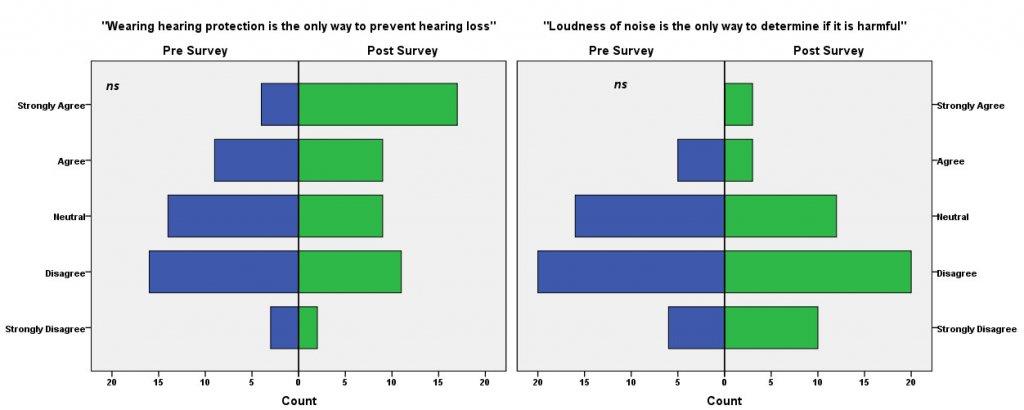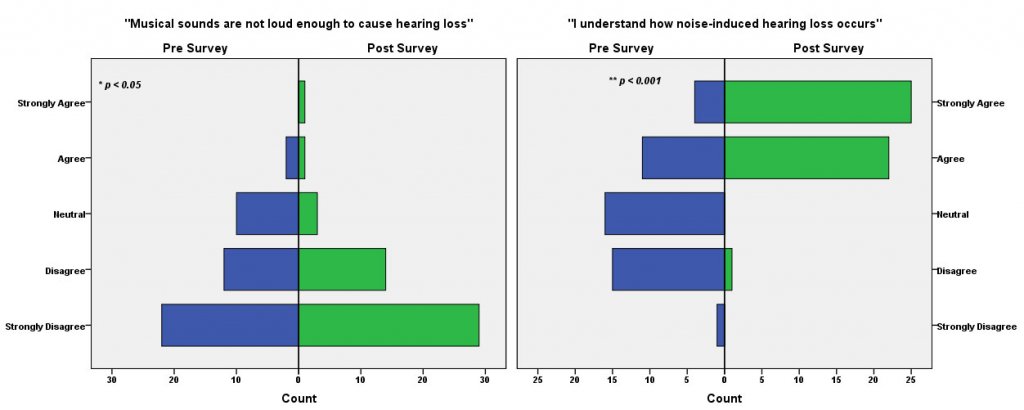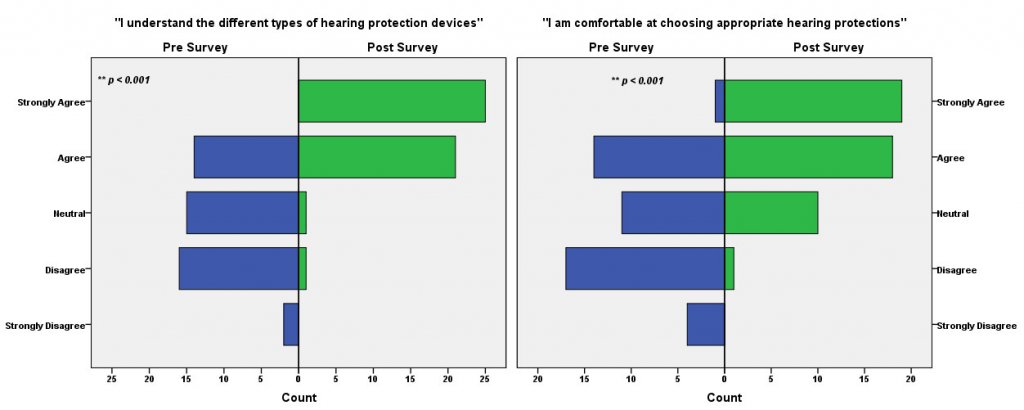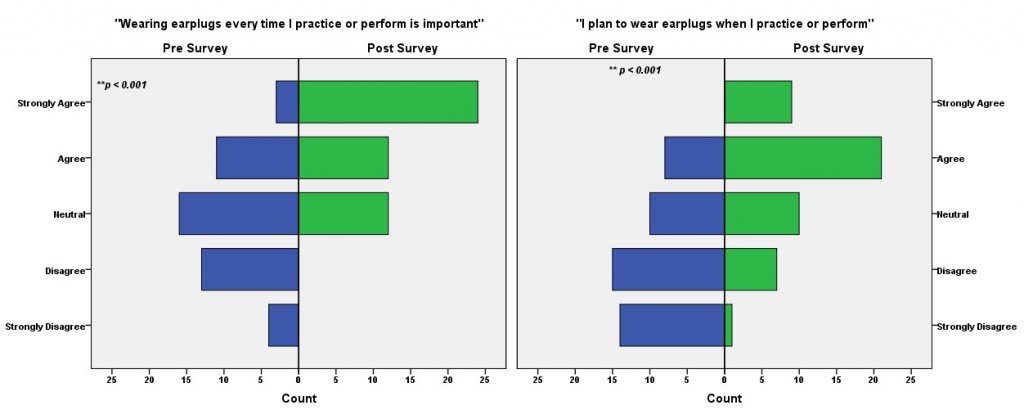A Hearing Conservation Education Program for Music Students
INTRODUCTION
About 5-10% of the hearing loss in the United States can be attributed to occupational noise exposure.1 Previous research has shown that music professionals are routinely exposed to hazardous levels of occupational noise.2-3 Musicians risk exposure to long durations and high intensity levels of sound while taking part in routine practices, rehearsals, and performances. For example, according to the National Institute of Occupational Health (NIOSH), noise evaluation of elementary and high school music classes and rehearsals revealed that the noise level of an average rehearsing location is approximately 94 dBA, sometimes exceeding 100 dBA.4 In college settings, during an average week, musicians could receive higher than average exposure than non-musicians.5 Furthermore, musical instruments and loudspeakers, often only inches away from a musician’s ear, serve as the culprits of loud sound within these locations, putting them at risk for harmful exposure.6-8 These instruments and settings of practices and performances often exceed the Occupational Safety and Health Administration’s (OSHA) regulations, thereby leading to the irreversible effects in the peripheral auditory system and causing long term damage to hearing.
Although NIOSH has published extensive information regarding noise exposure, limits and risks of hazardous noise levels in the musical industry, and has given recommendations to reduce occupational exposure, most musicians still do not wear hearing protection while being in proximity to their instruments or the instruments of their peers.9 Previous research has shown that many of the musicians may not be aware of the potentially detrimental effects of the loud intensity and frequency they encounter regularly.10 Thus, hearing conservation and early intervention programs could be beneficial to musicians in order to increase the overall understanding of the potential harm of occupational noise exposure.
For audiologists, one of the important roles within our scope of practice is to raise awareness about the long-term effects and irreversible damage of loud noise exposure and to advocate for the importance of wearing hearing protection during occupational or recreational noise exposure.11 The purpose of this study, therefore, is to educate early career musicians about the deleterious effects of occupational noise exposure, as well as to examine the efficacy of a hearing conservation education program for them.
METHODS
An educational program regarding hearing conservation and occupational noise exposure was given to a total of 75 undergraduate and graduate music major students of the University of the Pacific in Stockton, California. The goal of the educational program was to educate music students in regard to hearing loss and noise exposure. Specifically, what is defined as noise exposure and how does it affect the auditory system, how much of that can cause noise-induced hearing loss and the long-term consequences of it, and the importance and proper usage of hearing protection during practice and performance.
A questionnaire was used to examine whether there were changes regarding participants’ knowledge, attitudes, and beliefs before and after the education program. The questionnaire was distributed before, and immediately after the educational program. The questionnaire was adapted from the “Perception on Hearing Protection and Hearing Loss” – a U.S. National Institute for Occupational Safety and Health (NIOSH) questionnaire.12 The questionnaire consisted of 22 questions and analysis was focused on the following eight sub-categories: (1) perceived susceptibility to hearing loss, (2) perceived severity of consequences, (3) perceived benefits of preventive action, (4) perceived comfort, (5) perceived important sound awareness, (6) social norms, (7) hearing conservations, and (8) behavioral intentions and self-efficacy. Evaluation of the questions used the Likert Scale that ranges from “Strongly Disagree - 1” to “Strongly Agree - 5.”
Participants’ responses from the pre- and post-questionnaire were coded and analyzed to determine statistical significance of changes regarding attitudes and beliefs among the eight categories mentioned earlier. A non-parametric Wilcoxon Ranked Test was utilized in this evaluation (α = 0.05).
RESULTS
Participants’ Prior Knowledge
Participants’ prior knowledge of hearing loss and prevention was evaluated with two questions (Figure 1). Neither question showed statistical significance between pre- and post-questionnaire results. This suggests that music students already had prior knowledge of the content that was assessed. For question “Wearing hearing protection is the only way to prevent hearing loss”, more participants agreed more strongly with the statement after the education program, however the change was not statistically significant. For question “Loudness of noise is the only way to determine if it is harmful”, it showed that most of the participants disagreed even before the program, indicating that they were already aware that there are other measures to evaluate if a loud sound is harmful. Results from these two questions suggest that, overall, music students have a certain amount of knowledge in these areas prior to the educational program.

Hearing Loss Susceptibility
The aim of this category is to examine whether the participants were aware of their vulnerability to hearing loss (Figures 2 and 3). Responses from all questions asked in this category were all significantly different (p < 0.01) after the education program. This may suggest that, as a result of this program, music students had a much better understanding of how noise-induced hearing loss occurs and that musicians are one of the occupational groups with higher risk, especially in the environment that they practice and perform.


Consequence of Noise-Induced Hearing loss
This question was aimed at determining participants’ knowledge regarding the effects of noise-induced hearing loss (Figure 4). Results revealed a statistically significant (p < 0.001) change in the participants’ responses before and after the program. Most participants “Strongly Agreed” that they were knowledgeable about the consequences of hearing loss after the program, indicating an increased awareness about the impact of noise-induced hearing loss.

Preventative Action Awareness
Two questions were asked to measure preventative action awareness (Figure 5). Responses from questions asked in this category were significantly (p < 0.001) different after the education program. Most of the participants agreed that they understand different types of hearing protection devices and they are more comfortable choosing the appropriate type after this program.

Behavioral Beliefs and Intentions
Attitudes about hearing protection were measured after the educational program with two questions, as shown in Figure 6. Responses from questions asked in this category were significantly different (p < 0.001) after the education program. For question “Wearing earplugs every time I practice or perform is important”, it showed that most of the participants strongly agree with the statement. This indicates that, post-programming, most of the participants consider it is important to wear hearing protection when they practice or perform. For question “I plan to wear earplugs when I practice or perform”, results also showed an increased number of participants who plan to wear earplugs during practice or performance in the future. Most participants “Agreed” to wearing hearing protection, after receiving information from the program about their benefit and aid in preventing hearing loss and damage.

DISCUSSION
Results from this study showed that an educational program presented to early career music professionals can provide better understanding and help shape their desired beliefs and attitudes towards occupational noise exposure and hearing protection. Majority of the questions resulted in a statistically significant change in awareness and attitudes, confirming the effectiveness of this program in conveying the educational message. However, some of the questions, specifically the “attitude type” questions, revealed an interesting pattern about the differences in music students’ knowledge and their planned actions. For example, as mentioned above, although there was a statistically significant change in both of the questions “Wearing earplugs every time I practice or perform is important” and “I plan to wear ear plugs when I practice or perform”, there were way more music students who chose “Strongly Agree” in the “It is important” question than those answered the same in the “I plan to do so” one. It suggests that this hearing conservation program may have been more effective in occupational noise exposure education than shaping the desired attitudes and beliefs, as well as the participant’s future course of actions. Further investigation in factors that are contributing or hindering the desired change in attitudes and beliefs may provide a better understanding and reference in terms of further enhancing future hearing conservation programs.
CONCLUSION
Results from this study demonstrated that a hearing conservation program could be beneficial to students of early music careers. After completing the program, participants had more awareness of how their professional environment can have a potential negative impact on the auditory system. They also reported that they were more inclined to wear hearing protection devices during practice and performance. Implementing such education program as early as possible in the music students’ curriculum may be important. It may help advocate for preventative measures and to promote attitudes and beliefs that minimize hazardous noise exposure in the field of the musician early in their career.
REFERENCES
- Dobie RA. The burdens of age-related and occupational noise-induced hearing loss in the United States. Ear Hear 2008;29(4):565–577.
- Stadio AD. Which factors to induce hearing loss in professional musicians? Extensive literature review and histopathology findings can answer it. Hear Balance Communicat 2017;15(2):63–71.
- Washnik NJ, Phillips SL, Teglas S. Student’s music exposure: Full-day personal dose measurements. Bimonthly Interdisciplin Internat J 2016;18(81):98–103.
- Chen L, Brueck SE. Health Hazard Evaluation report: noise evaluation of elementary and high school music classes and indoor marching band rehearsals. Alabama: 2012. Available at: http://www. cdc.gov/niosh/hhe/reports/pdfs/2011-0129-3160.pdf.
- Tufts JB, Skoe E. Examining the noisy life of the college musician: weeklong noise dosimetry of music and non-music activities. Internat J Audiol 2018;57:S20-S27.
- Behar A, Chasin M, Mosher S, Abdoli-Eramaki M, Russo FA. Noise exposure and hearing loss in classical orchestra musicians: A five-year follow-up. Noise Health 2018;20(93):42–46.
- Kahari KR, Axelsson A, Hellstrom P, Zachau G. Hearing assessment of classical orchestral musicians. Scand Audiol 2001;30:13–23.
- Phillips SL, Henrich VC, Mace ST. Prevalence of noise-induced hearing loss in student musicians. Internat J Audiol 2010;49:309–16.
- Kardous C, Themann C, Morata T, Reynolds J, Afanuh S. Reducing the risk of hearing disorders among musicians. DHHS (NIOSH) 2015;184.
- Pouryaghoub G, Mehrdad R, Pourhosein S. Noise-Induced hearing loss among professional musicians. J Occupat Health 2017;59(1):33–37.
- American Speech-Language-Hearing Association. Scope of Practice in Audiology. Rockville, MD: American Speech-Language-Hearing Association; 2018.
- Keppler H, Dhooge I, Vinck B. Hearing in young adults. Part I: The effects of attitudes and beliefs toward noise, hearing loss, and hearing protector devices. Noise Health 2015;17(78):237–44.

